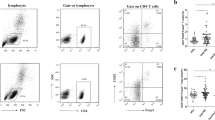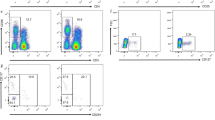Abstract
Objectives
CD200 is expressed on various cell types, including T cells, while the CD200 receptor (CD200R) is expressed on myeloid cells such as monocytes-derived macrophages (MDMs). The CD200–CD200R interaction has been shown to play an important role in the prevention of autoimmune disease. Thus, we hypothesized that CD200/CD200R1 is involved in the pathogenesis of rheumatoid arthritis (RA).
Methods
In total, 35 RA patients and 17 healthy controls (HCs) were enrolled in this study. CD200/CD200R1 expression and Th17/Treg were examined by flow cytometry. Serum levels of interleukin (IL)-2, interferon-γ (IFN-γ), IL-4 and IL-10 were detected by ELISA. Disease activity was evaluated according to the C-reactive protein (CRP) levels, erythrocyte sedimentation rates (ESR) and 28-joint disease activity score (DAS28) scores.
Results
Compared with HCs, RA patients exhibited a significantly decreased level of CD200R1 on MDMs. CD200R1 expression correlated negatively with DAS28, ESR, and CRP levels. This abnormal expression was associated with Th17/Treg imbalance in the active RA patients. However, expression of CD200R1 was not correlated with Th1 (IL-2, IFN-γ) or Th2 (IL-4, IL-10) cytokine responses.
Conclusion
In this study, we demonstrate a significant correlation between CD200R1+ cells and disease severity in RA patients, thus indicating the relevance of the CD200/CD200R1 signaling pathway's potential involvement in the pathogenesis of RA.







Similar content being viewed by others
References
Firestein GS. Evolving concepts of rheumatoid arthritis. Nature. 2003;423:356–61.
Feldmann M, Brennan FM, Maini RN. Role of cytokines in rheumatoid arthritis. Annu Rev Immunol. 1996;14:397–440.
McInnes IB, Schett G. The pathogenesis of rheumatoid arthritis. N Engl J Med. 2011;365:2205–19.
Gordon S, Taylor PR. Monocyte and macrophage heterogeneity. Nat Rev Immunol. 2005;5:953–64.
Yudoh K, Matsuno H, Nakazawa F, Yonezawa T, Kimura T. Reduced expression of the regulatory CD4+ T cell subset is related to Th1/Th2 balance and disease severity in rheumatoid arthritis. Arthr Rheum. 2000;43:617–27.
Fontenot JD, Rudensky AY. A well adapted regulatory contrivance: regulatory T cell development and the forkhead family transcription factor Foxp3. Nat Immunol. 2005;6:331–7.
Pernis AB. Th17 cells in rheumatoid arthritis and systemic lupus erythematosus. J Intern Med. 2009;265:644–52.
Boissier MC, Assier E, Falgarone G, Bessis N. Shifting the imbalance from Th1/Th2 to Th17/Treg: the changing rheumatoid arthritis. Joint Bone Spine. 2008;75:373–5.
Wright GJ, Jones M, Puklavec MJ, Brown MH, Barclay AN. The unusual distribution of the neuronal/lymphoid cell-surface CD200 (OX2) glycoprotein is conserved in humans. Immunology. 2001;102:173–9.
Wright GJ, Cherwinski H, Foster-Cuevas M, Brooke G, Puklavec MJ, Bigler M, et al. Characterization of the CD200 receptor family in mice and humans and their interactions with CD200. J Immunol. 2003;171:3034–46.
Gorczynski RM, Chen Z, Kal Y, Lee L, Wong S, Marsden PA. CD200 is a ligand for all members of the CD200R family of immunoregulatory molecules. J Immunol. 2004;172:7744–9.
Gorczynski RM. Transplant tolerance modifying antibody to CD200 receptor, but not CD200, alters cytokine production profile from stimulated macrophages. Eur J Immunol. 2001;31:2331–7.
Hoek RM, Ruuls SR, Murphy CA, Wright GJ, Goddard R, Zurawski SM, et al. Down-regulation of the macrophage lineage through interaction with OX2 (CD200). Science. 2000;290:1768–71.
Broderick C, Hoek RM, Forrester JV, Liversidge J, Sedgwick JD, Dick AD. Constitutive retinal CD200 expression regulates resident microglia and activation state of inflammatory cells during experimental autoimmune uveoretinitis. Am J Pathol. 2002;161:1669–77.
Gorczynsi RM, Chen Z, Yu K, Hu J. CD200 immunoadhesin suppresses collagen-induced arthritis in mice. Clin Immunol. 2001;101:328–34.
Koning N, Bö L, Hoek RM, Huitinga I. Downregulation of macrophage inhibitory molecules in multiple sclerosis lesions. Ann Neurol. 2007;62:504–14.
Garza LA, Yang CC, Zhao T, Blatt HB, Lee M, He H, et al. Bald scalp in men with androgenetic alopecia retains hair follicle stem cells but lacks CD200-rich and CD34-positive hair follicle progenitor cells. J Clin Invest. 2011;121:613–22.
Coles SJ, Hills RK, Wang EC, Burnett AK, Man S, Darley RL, et al. Increased CD200 expression in acute myeloid leukemia is linked with an increased frequency of FoxP3+ regulatory T cells. Leukemia. 2012;26:2146–8.
Rygiel TP, Karnam G, Goverse G, van der Marel AP, Greuter MJ, van Schaarenburg RA. CD200–CD200R signaling suppresses antitumor responses independently of CD200 expression on the tumor. Oncogene. 2012;31:2979–88.
Arnett FC, Edworthy SM, Bloch DA, McShane DJ, Fries JF, Cooper NS, et al. The American Rheumatology Association revised criteria for the classification of rheumatoid arthritis. Arthr Rheum. 1987;1988(31):315–24.
Hepburn AL, Mason JC, Davies KA. Expression of Fcgamma and complement receptors on peripheral blood monocytes in systemic lupus erythematosus and rheumatoid arthritis. Rheumatology (Oxford). 2004;43:547–54.
Baran J, Kowalczyk D, Ozóg M, Zembala M. Three-color flow cytometery detection of intracellular cytokine in peripheral blood mononuclear cells: comparative analysis of phorbol myristate acetate-ionomycin and phytohemagglutinin stimulation. Clin Diagn Lab Immunol. 2001;8:303–13.
Jenmalm MC, Cherwinski H, Bowman EP, Phillips JH, Sedgwick JD. Regulation of myeloid cell function through the CD200 receptor. J Immunol. 2006;176:191–9.
Mihrshahi R, Barclay AN, Brown MH. Essential roles for Dok2 and RasGAP in CD200 receptor-mediated regulation of human myeloid cells. J Immunol. 2009;183:4879–86.
Brentano F, Kyburz D, Schorr O, Gay R, Gay S. The role of Toll-like receptor signalling in the pathogenesis of arthritis. Cell Immunol. 2005;233:90–6.
Snelgrove RJ, Goulding J, Didierlaurent AM, Lyonga D, Vekaria S, Edwards L, et al. A critical function for CD200 in lung immune homeostasis and the severity of influenza infection. Nat Immunol. 2008;9:1074–83.
Nakae S, Nambu A, Sudo K, Iwakura Y. Suppression of immune induction of collagen-induced arthritis in IL-17-deficient mice. J Immunol. 2003;171:6173–7.
Lubberts E, van den Bersselaar L, Oppers-Walgreen B, Schwazenberger P, Coenen-de Roo CJ, Kolls JK. IL-17 promotes bone erosion in murine collagen-induced arthritis through loss of the receptor activator of NK-κB ligand/osteoprotegerin balance. J Immunol. 2003;170:2655–62.
Acosta-Rodriguez EV, Rivino L, Geginat J, Jarrossay D, Gattorno M, Lanzavecchia A, et al. Surface phenotype and antigenic specificity of human interleukin 17-producing T helper memory cells. Nat Immunol. 2007;8:639–46.
Houssiau FA, Devogelaer JP, Van Damme J, de Deuxchaisnes CN, Van Snick J. Interleukin-6 in synovial fluid and serum of patients with rheumatoid arthritis and other inflammatory arthritides. Arthr Rheum. 1988;31:784–8.
Nie H, Zheng Y, Li R, Guo TB, He D, Fang L, et al. Phosphorylation of FOXP3 controls regulatory T cell function and is inhibited by TNF-α in rheumatoid arthritis. Nat Med. 2013;19:322–8.
Bettelli E, Carrier Y, Gao W, Korn T, Strom TB, Oukka M. Reciprocal developmental pathways for the generation of path ogenic effector Th17 and regulatory T cells. Nature. 2006;441:235–8.
Wing K, Sakaguchi S. Regulatory T cells exert checks and balances on self tolerance and autoimmunity. Nature Immunol. 2010;11:7–13.
Evans HG, Gullick NJ, Kelly S, Pitzalis C, Lord GM, Kirkham BW, et al. In vivo activated monocytes from the site of inflammation in humans specifically promote Th17 responses. Proc Natl Acad Sci USA. 2009;106:6232–7.
Jiao Z, Hua S, Wang W, Wang H, Gao J, Wang X. Increased circulating myeloid-derived suppressor cells correlated negatively with Th17 cells in patients with rheumatoid arthritis. Scand J Rheumatol. 2013;42:85–90.
Pallasch CP, Ulbrich S, Brinker R, Hallek M, Uger RA, Wendtner CM. Disruption of T cell suppression in chronic lymphocytic leukemia by CD200 blockade. Leuk Res. 2009;33:460–4.
Gorczynsi RM, Lee L, Boudakov I. Augmented induction of CD4+CD25+ Treg using monoclonal antibodies to CD200R. Transplantation. 2005;79:1180–3.
Simelyte E, Alzabin S, Boudakov I, Williams R. CD200R1 regulates the severity of arthritis but has minimal impact on the adaptive immune response. Clin Exp Immunol. 2010;162:163–8.
Acknowledgments
This study was supported by grants from the Scientific Research Foundation of Zhejiang Provincial Education Department (Y201121334) (Y201226006), Medical Science and Technology Project of Zhejiang Province (2012KYB088), and Science and Technology Project of Zhejiang Province Department of Science and Technology (2012F82G2010026) (2013C33G2010397).
Conflict of interest
None.
Author information
Authors and Affiliations
Corresponding author
Additional information
Responsible Editor: Liwu Li.
S. Gao and B. Hao contributed equally to this work and should be considered co-first authors.
Rights and permissions
About this article
Cite this article
Gao, S., Hao, B., Yang, X.F. et al. Decreased CD200R expression on monocyte-derived macrophages correlates with Th17/Treg imbalance and disease activity in rheumatoid arthritis patients. Inflamm. Res. 63, 441–450 (2014). https://doi.org/10.1007/s00011-014-0716-6
Received:
Accepted:
Published:
Issue Date:
DOI: https://doi.org/10.1007/s00011-014-0716-6




